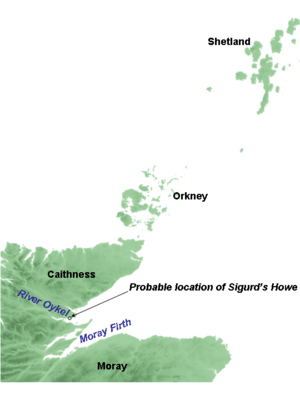Sigurd Eysteinsson facts for kids

Sigurd Eysteinsson, also known as Sigurd the Mighty, was an important Viking leader. He ruled as the second Earl of Orkney from about 875 to 892 AD. An Earl was a powerful ruler, similar to a duke or count, in charge of a large area. Sigurd got this title from his brother, Rognvald Eysteinsson.
Sigurd was a key figure in the Viking conquest of what is now northern Scotland. He was famous for his bravery and leadership during these times. Sadly, Sigurd died in a very unusual way. He was riding his horse with the head of an enemy leader, Máel Brigte, attached to his saddle. One of Máel Brigte's teeth scratched Sigurd's leg. The wound got infected, and this sickness eventually caused Sigurd's death.
Contents
Stories from the Sagas
Most of what we know about Sigurd's life comes from old Norse stories called sagas. The two main sagas are the Heimskringla and the Orkneyinga. These sagas are like historical tales written long ago.
According to these stories, after a big battle called the Battle of Hafrsfjord around 872 AD, the kingdom of Norway became united. Many Vikings who didn't like the new king, Harald Fairhair, fled to the Orkney and Shetland islands. From there, they would raid Norway.
King Harald Fairhair decided to stop these pirate Vikings. He got help from Rognvald Eysteinsson, Sigurd's brother. During this fight, Rognvald's son, Ivar, was killed. To make up for this loss, King Harald gave Rognvald the Orkney and Shetland islands. He also gave him the title of Earl.
Rognvald, with King Harald's permission, then gave the islands and the Earl title to his brother, Sigurd. Sigurd was one of King Harald's trusted leaders.
Expanding His Kingdom
Sigurd was not content with just the islands. He teamed up with another Viking leader, Thorstein the Red. Together, they expanded their control onto the Scottish mainland. They conquered areas like Caithness and Sutherland. Their rule stretched at least as far south as a place called Ekkjalsbakka. This area was likely near the river Oykel.
Sigurd's success in conquering northern Scotland made him a legend. People started calling him "the Mighty." In the old Norse language, this was ríki.
The Strange Death of Sigurd
The Orkneyinga saga tells the story of Sigurd's unusual death. Near the end of his rule, Sigurd challenged a local Scottish ruler named Máel Brigte the Buck-Toothed to a battle. They agreed to fight with 40 men on each side.
However, Sigurd cheated and brought 80 men to the fight. Máel Brigte was defeated and killed. Sigurd cut off Máel Brigte's head and tied it to his saddle as a trophy. But as Sigurd rode, one of Máel Brigte's teeth scratched his leg.
The scratch became very sore and infected. Sigurd got very sick from the infection and eventually died.
Where is Sigurd Buried?
Sigurd was buried in a large mound of earth, which is called a tumulus or a "howe." This burial place became known as Sigurd's Howe, or Sigurðar-haugr in Old Norse. The word haugr means mound or barrow.
Most historians believe that Sigurd's Howe is located near modern-day Sidera or Cyderhall, close to Dornoch in Scotland. However, some people have suggested he might have been buried at Burghead in Moray.
After Sigurd's death, there was a time of trouble in the Orkney Earldom. His son, Guttorm, became Earl but died within a few months. Rognvald then made another son, Hallad, the Earl of Orkney. But Hallad couldn't control the pirate Vikings and soon gave up his title. He returned to Norway. The sagas say that Rognvald's other sons were more interested in conquering other places. So, the earldom was eventually given to Rognvald's youngest son, Einarr.

